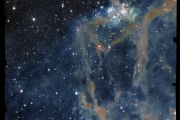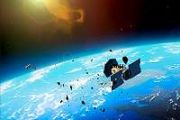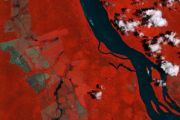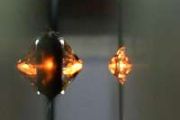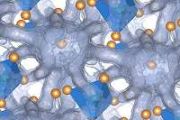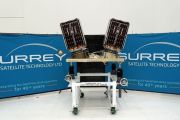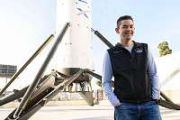
Copernical Team
Sea-level monitoring satellite unboxed

Following its arrival in California a few weeks ago, the time has come for spacecraft engineers to ready the next sea-level monitoring satellite, Copernicus Sentinel-6B, for launch, which is slated for November.
The first step has been to carefully remove this precious new satellite from its storage container and to start a series of comprehensive checks.
Advancing Europe’s quantum secure communications from space

The European Space Agency (ESA) has signed a €50 million contract with aerospace company Thales Alenia Space to begin the preliminary design phase of the Security And cryptoGrAphic (SAGA) mission. This agreement enables SAGA to continue to its preliminary design review, marking a relevant step towards establishing secure, space-based communications using quantum technologies.
From inner to outer space
 Image:
From inner to outer space
Image:
From inner to outer space Australia Japan partnership to accelerate laser links for satellites
 A new collaboration between the University of South Australia, Adelaide start-up RapidBeam, and Japan's Warpspace aims to speed development of next-generation space laser communications. The agreement targets faster, more secure, and more reliable data transfer than today's radio-based systems for missions spanning Earth observation to deep space.
At the core is Warpspace's HOCSAI optical
A new collaboration between the University of South Australia, Adelaide start-up RapidBeam, and Japan's Warpspace aims to speed development of next-generation space laser communications. The agreement targets faster, more secure, and more reliable data transfer than today's radio-based systems for missions spanning Earth observation to deep space.
At the core is Warpspace's HOCSAI optical Spongy space dust reshapes understanding of star and planet formation
 Cosmic dust - the tiny particles that seed stars, planets and the chemistry of life - may be far less solid than once assumed. A new review by an international research team suggests many grains are porous, sponge-like structures rather than compact rocky fragments.
Professor Martin McCoustra of Heriot-Watt University, working with colleagues in Germany, Japan, the USA and Spain, helped co
Cosmic dust - the tiny particles that seed stars, planets and the chemistry of life - may be far less solid than once assumed. A new review by an international research team suggests many grains are porous, sponge-like structures rather than compact rocky fragments.
Professor Martin McCoustra of Heriot-Watt University, working with colleagues in Germany, Japan, the USA and Spain, helped co A New Model of Water in Jupiter's Atmosphere
 Caltech researchers have developed a new simulation of the hydrological cycle on Jupiter, modeling how water vapor condenses into clouds and falls as rain throughout the giant planet's swirled, turbulent atmosphere. The research shows that Jupiter's water is not uniformly distributed, giving missions like NASA's Juno orbiter important guidance about where to look for water on the planet.
J
Caltech researchers have developed a new simulation of the hydrological cycle on Jupiter, modeling how water vapor condenses into clouds and falls as rain throughout the giant planet's swirled, turbulent atmosphere. The research shows that Jupiter's water is not uniformly distributed, giving missions like NASA's Juno orbiter important guidance about where to look for water on the planet.
J 3 Questions: How a new mission to Uranus could be just around the corner
 The successful test of SpaceX's Starship launch vehicle, following a series of engineering challenges and failed launches, has reignited excitement over the possibilities this massive rocket may unlock for humanity's greatest ambitions in space. The largest rocket ever built, Starship and its 33-engine "super heavy" booster completed a full launch into Earth orbit on Aug. 26, deployed eight test
The successful test of SpaceX's Starship launch vehicle, following a series of engineering challenges and failed launches, has reignited excitement over the possibilities this massive rocket may unlock for humanity's greatest ambitions in space. The largest rocket ever built, Starship and its 33-engine "super heavy" booster completed a full launch into Earth orbit on Aug. 26, deployed eight test Telespazio and ispace Partner on Lunar Transport and Navigation Services
 Telespazio, a joint venture between Leonardo (67 percent) and Thales (33 percent), and lunar exploration company ispace have signed a Letter of Intent to begin technical and commercial collaboration to advance lunar transport and communications. The agreement focuses on leveraging ispace's orbital transfer vehicle capabilities in support of ESA's Moonlight Lunar Navigation and Communication Serv
Telespazio, a joint venture between Leonardo (67 percent) and Thales (33 percent), and lunar exploration company ispace have signed a Letter of Intent to begin technical and commercial collaboration to advance lunar transport and communications. The agreement focuses on leveraging ispace's orbital transfer vehicle capabilities in support of ESA's Moonlight Lunar Navigation and Communication Serv Researchers ID new mineral on Mars, providing insight on potential early life
 Researchers from the University of Massachusetts Amherst are part of a team that has identified a unique mineral on Mars, described in Nature Communications. Named ferric hydroxysulfate, the mineral provides clues about the Martian environment and history of the planet, including the possibility of former lava, ash or hydrothermal activity.
Mars gets its trademark red hue from the abundanc
Researchers from the University of Massachusetts Amherst are part of a team that has identified a unique mineral on Mars, described in Nature Communications. Named ferric hydroxysulfate, the mineral provides clues about the Martian environment and history of the planet, including the possibility of former lava, ash or hydrothermal activity.
Mars gets its trademark red hue from the abundanc Cassini proves complex chemistry in Enceladus ocean

Scientists digging through data collected by the Cassini spacecraft have found new complex organic molecules spewing from Saturn’s moon Enceladus. This is a clear sign that complex chemical reactions are taking place within its underground ocean. Some of these reactions could be part of chains that lead to even more complex, potentially biologically relevant molecules.
Published today in Nature Astronomy, this discovery further strengthens the case for a dedicated European Space Agency (ESA) mission to orbit and land on Enceladus.

